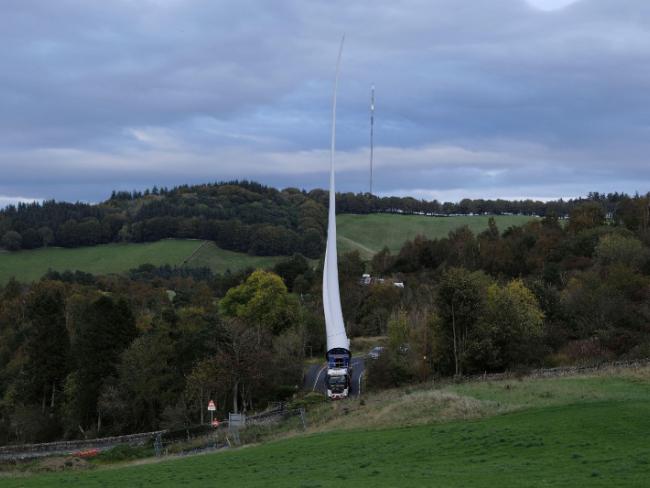10 April 2024

The scale of large wind turbines is immense. Convoy moving just one blade, on route to Pines Burn wind farm near Hawick, Scottish Borders last October. These will be up to 150 metres high; even larger ones are proposed in Wales and elsewhere across Britain. Photo Rob Gray / Alamy.
The devolved government in Wales continues to approve ever larger wind turbines in dogmatic pursuit of net zero policies in the face of many objections. In doing so it’s very much in line with the energy polices for Scotland and the UK as a whole.
Before 2020, wind turbines in Wales were relatively small – usually less than 107 metres high (350 feet) to turbine tip. But then the Welsh Government published a new policy, Future Wales – the National Plan 2040. This contained three crucial changes to the planning regime in relation to wind power.
The first was that large wind energy developments should be decided by Labour ministers, not councils. “Large” means anything over 10 megawatts (MW) – equivalent to just two to three of the current generation of 4 MW turbines. It means almost all wind farm applications are now approved in Cardiff.
Presumption
The second change introduced was a “presumption in favour of large-scale wind energy developments” – meaning more and taller turbines – the latest models can be up to up to 250 metres in height. Such huge machines were previously only deployed offshore.
The final and most important change was to create “Pre-Assessed Areas for Wind Energy”. This means vast areas of Wales are deemed suitable for wind farms whatever locals might think. Only national parks and areas of outstanding beauty are exempt. The policy did not even consider promoting offshore wind power.
Opponents ignored
Opponents of these large onshore wind turbines are routinely ignored. RWE, a German energy firm, wants to erect nine turbines up to 200 metres high in Denbighshire, north-east of Bala called the Gaerwen Wind Farm. RWE admits that more than three in four of local people are opposed to the project but said it plans to go ahead anyway.
The same is true of other tall wind farms. The largest is Lan Fawr in Ceredigion where Bute Energy plans to install 40 turbines, each 244 metres tall to blade tip. Opposition includes people in Powys who will see these enormous wind turbines.
To transfer the energy from this wind farm there will be a 32 mile long 132 kV overhead cable on pylons to a new National Grid substation near Carmarthen. This will be overseen by Green GEN Cymru which just happens to be part of the Bute Energy group
Controversial
Another controversial proposal is the Twyn Hywel Wind Farm on Mynydd Eglwysilan, a 1,200-foot hill in Caerphilly county. Bute Energy’s plans for this includes 14 turbines each 200 metres high, which has provoked anger in local communities.
There are other wind farms nearing construction as well, either approved or waiting for approval. For the Aberedw Energy Park the landowner expects to earn up to £500,000 per year for allowing Bute Energy to install 18 turbines, also 200 metres high, on his large estate.
‘Local opposition to tall wind turbines is common.’
Local opposition to such tall wind turbines is common. The Welsh Government claimed a public consultation but they have also claimed that on other controversial measures only to find opposition much greater than they thought. They also claim the wind farm projects require public consultation but clear opposition does not mean the project is stopped.
Across Britain
Once on the National Grid, power generated is not confined to where it is generated and can be used anywhere in Britain – or even exported through underwater connectors. Britain’s energy supply must be considered as a whole.
But the policy is the same in all parts of Britain. The Scottish government opposes any new oil or gas exploitation and is hell-bent on wind power, taking much the same approach to opposition as its Welsh counterpart. The UK government has followed with similar changes to planning law for England.
Potential
Labour should concentrate on proposed plans to quadruple offshore wind power using floating wind farms off Britain’s coast which do not have the same opposition (or “blockers”). The potential for offshore wind, including off the Welsh coast, is significant.
But according to a Daily Telegraph report on 1 April, the people of Wales at least are not taking all this lying down. There are strong objections from groups like CPRW Wales and protests springing up across the region. Some of these are finding common cause with farmers enraged by the attitude of the Welsh government to their industry.
